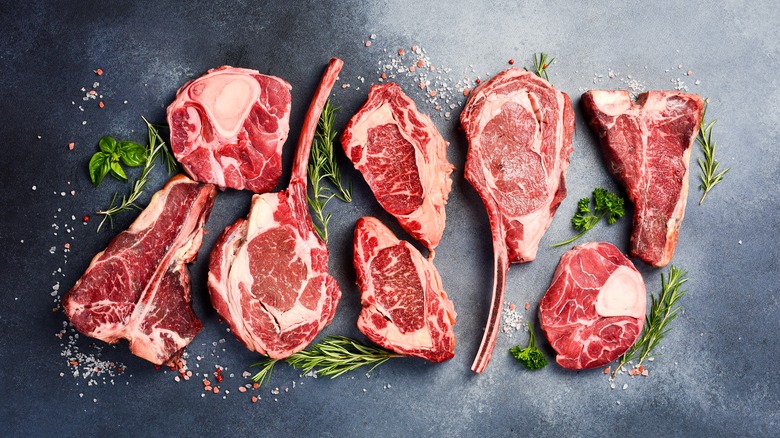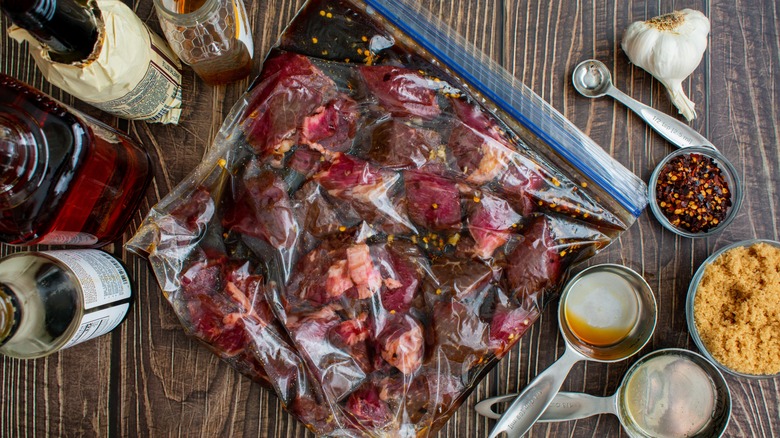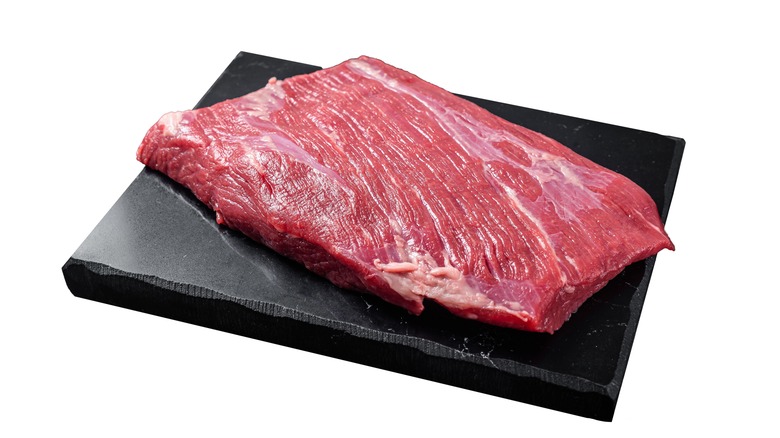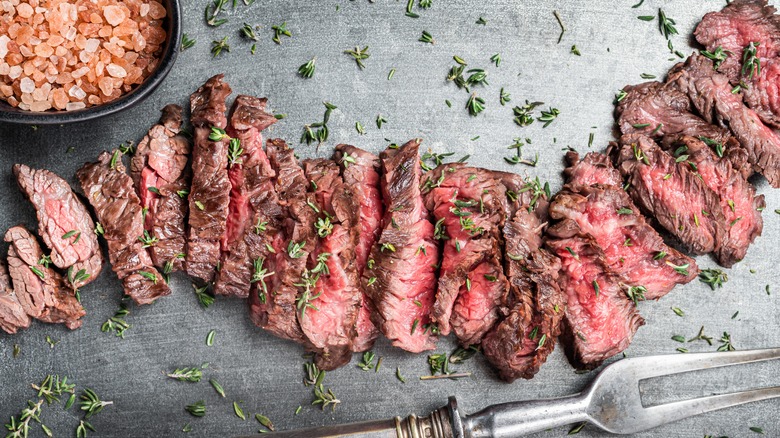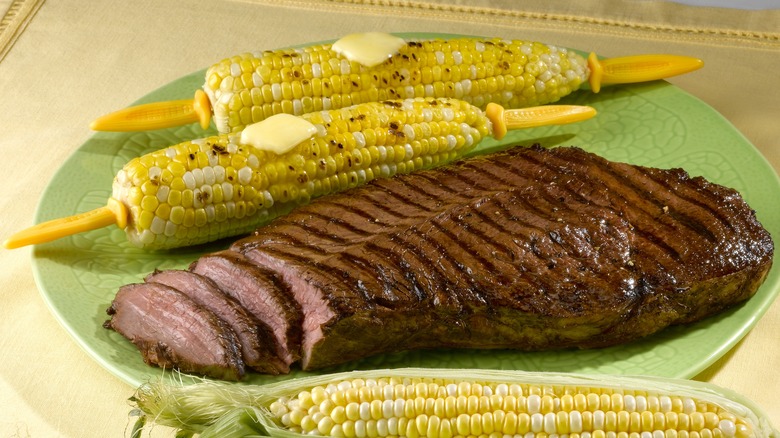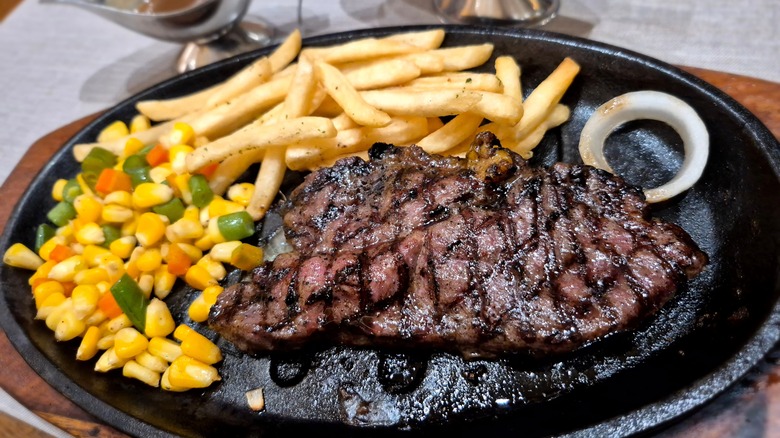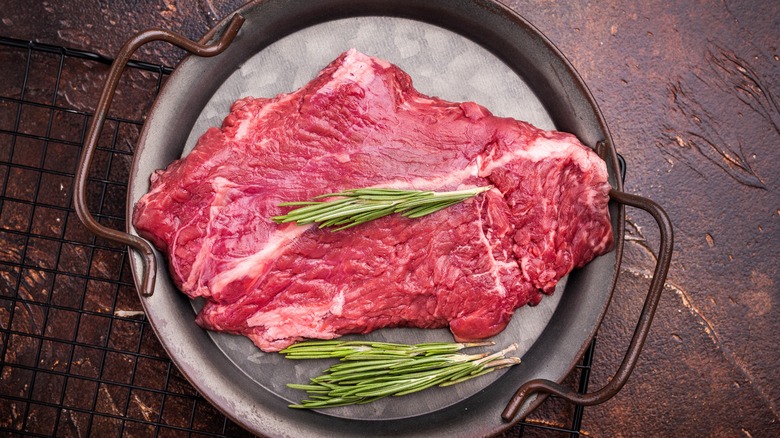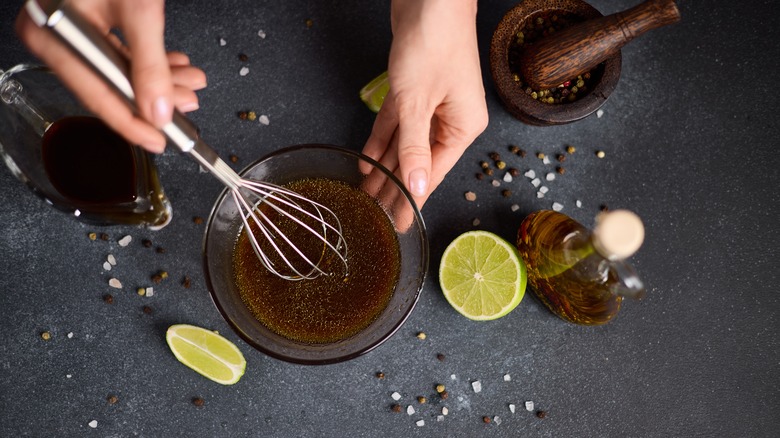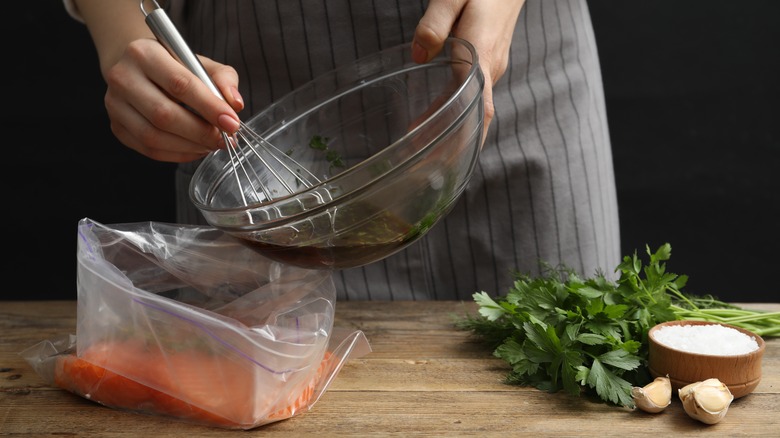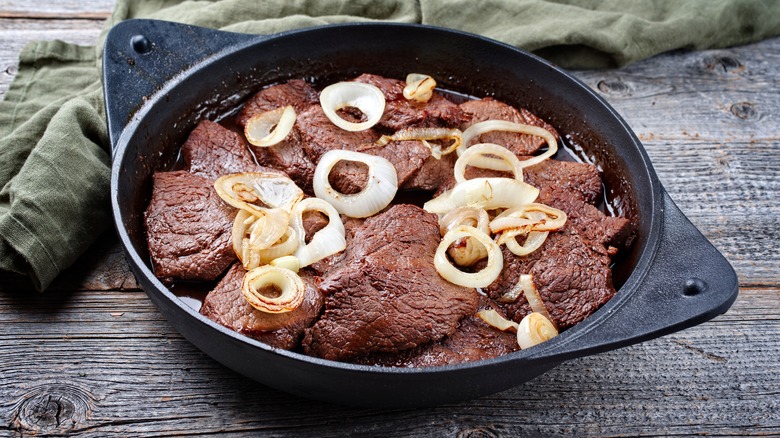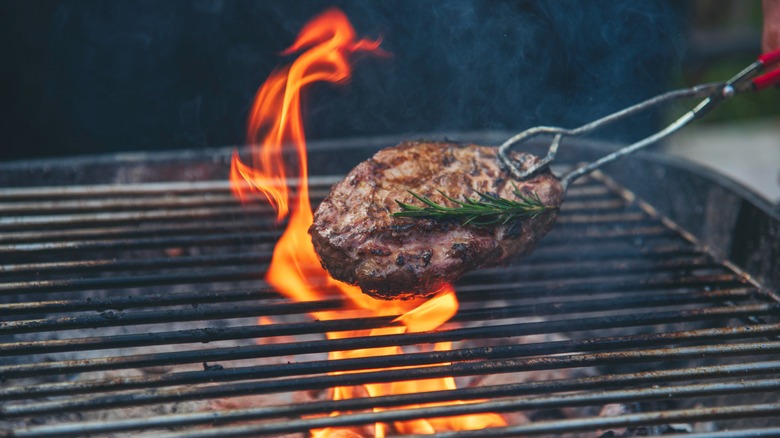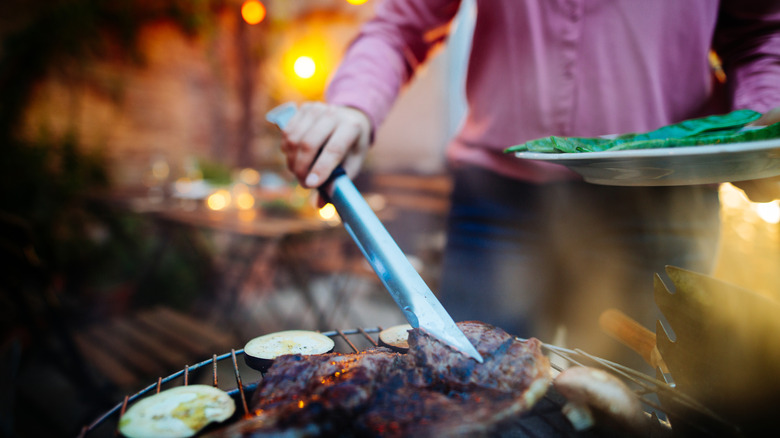Experts Reveal The Cuts Of Steak You Should Always Marinate Before Grilling & How To Do It
We may receive a commission on purchases made from links.
Does anything scream summer more than a backyard grill sizzling with meat? From tailgates to Tuesday night dinners, the grill is a great way to enjoy the outdoors while preparing a meal. It is also the best way to get a great sear without setting off your smoke alarms. Not every cut of meat can stand up to the heat, though. Many cuts of steak benefit from a little marination before they hit the grill.
Marinating a steak does two things: It salts the meat all the way through and adds additional flavors to the meat's exterior. The salt components of a marinade also help the meat stay juicy after high-heat cooking. This is why marinating is such a great move for steaks you plan to grill.
There are a couple of ways your marinade could go wrong, though. So we spoke to chefs and beef experts chef Maricel Gentile of Maricel's Kitchen, rancher Justin Owens, owner of Manzo Piedmontese, and chef Mike Tsarnas of Gabriella's Italian Steakhouse to get the goods on marinating steaks to grill. Let's explore the best cuts to marinate, how long to marinate, the best marinade compositions, and expert-recommended techniques and tools to make you a grill master.
Identifying marinade-friendly cuts
A successfully marinated and grilled steak starts with choosing the right cut of meat. The ideal steak for marinating has visible muscle grain and little to no fat marbling. If you are undecided about whether or not to marinade, Maricel Gentile suggests a simple touch test, "If the steak has more visible muscle grain, lower fat marbling, or feels a little tougher to the touch, that's a sign it's perfect for marinating."
Justin Owens adds that shoppers should also consider connective tissue when considering a steak to marinate and grill. "It is found in muscles that are most worked, so the round, the shank, abdomen, and shoulders." Any acidic components you add to a marinade will soften those connective tissues and turn your tough into a tender, flavorful bite.
There's no point spending the big bucks on a highly marbled steak or tender steak — like ribeye or filet mignon — if you plan to marinate it. Mike Tsarnas explains, "A marinade can actually take away from the natural taste and texture. For those, a little salt, pepper, and maybe a brush of butter while they cook is all you need."
The chefs' favorite: Flank steak
Flank steak is a lean cut from the cow's lower abdomen. It includes parts of the diaphragm and lower chest muscles, so it has that prized connective tissue our experts recommend. This long, flat cut features distinct muscle fibers that run in a single direction. It also has relatively little fat marbling. This leanness and distinctive grain make it the perfect canvas for marinades.
"Flank steak is my go-to. It needs flavor. It's lean, full of muscle fibers, and benefits deeply from a good marinade," says Maricel Gentile. This cut soaks up marinades beautifully, transforming it from a potentially tough to remarkably tender. For best results with flank steak, marinate for at least two hours and up to six hours.
Overnight marinades can also work — but not if your mix contains a lot of citrus or other acids. These can soften the meat dramatically, taking your steak from tender to mushy if you marinate for too long. Mike Tsarnas recommends a simple marinade "that has some acid in it, like vinegar or citrus, along with garlic, herbs, and olive oil" for flank steaks.
Once marinated, flank steak is best grilled over direct high heat for four to five minutes per side to get it to medium-rare. The most important step comes after cooking. Always slice flank steak against the grain to shorten those long muscle fibers. Cut it thin at a 45-degree angle, and you'll be rewarded with incredibly tender, flavorful meat.
The classic choice: Skirt steak
Skirt steak is a long, thin cut that comes from the diaphragm area of the cow. There are actually two cuts of skirt steak: the inside skirt and the outside skirt. They both come from the cow's abdomen, from a section known as "the plate," or the steer's diaphragm. The inside skirt is the shorter and slightly fattier of the two. It is also the most commonly available in grocery stores. The outside skirt is the longer, wider cut, that runs along the outside of the diaphragm. Outside skirt is pricier and most of what is available typically goes directly to restaurants.
Mike Tsarnas says skirt steak is an excellent candidate for marinating, "These cuts soak up whatever you use, whether it's garlic, herbs, olive oil, or something with acid." Skirt steak is thin, so it doesn't need long in the marinade. Two to four hours is plenty. When grilling skirt steak, remember that it cooks quickly, too. Two to three minutes per side over higher heat will typically get you a perfect medium-rare.
Skirt steak is the classic protein for Mexican carne asada. Though it makes a wonderful base for any marinades, Tsarnas goes a little farther south to Argentina for his favorite skirt steak. "I'm a big fan of a classic chimichurri-style marinade for skirt steak. The mix of garlic, parsley, vinegar, and olive oil gives it a ton of flavor and really brings out the best in that cut," he says.
London broil: Budget-friendly transformation
London broil isn't actually a cut of meat — it is a cooking method that became associated with certain cuts, though many cooks and chefs still use the title "London broil" to refer to top round. This large, lean cut comes from the cow's rear leg and offers tremendous value.
Top round is a prime candidate for marination because it is lean with minimal fat marbling and a tight grain structure. Due to its thickness and density, top round requires a longer marinade time than thinner cuts. Mike Tsarnas suggests, "The thicker the steak, the more time it needs." He adds, "For thicker cuts like sirloin or London broil, I'll let them go longer, maybe six to eight hours or overnight if the marinade is gentle." For London broil (aka top round) a marinade with good acidity further helps break down tough muscle fibers and tenderize the meat.
When grilling, use medium-high heat rather than the scorching temperatures suited for thinner cuts. After getting a good sear on both sides, move the meat to indirect heat to finish cooking. Like other meats on this list, top round is best sliced against the grain after cooking. Thin slices no thicker than ¼ inch provide the best eating experience.
Sirloin: Versatile and value-conscious
Sirloin is a cut that many chefs mention in the same breath as London broil. "These are all beautiful cuts that, when left on their own, can be a bit tough or bland. But with the right marinade, they become tender and flavorful," Maricel Gentile says.
Sirloin comes from the mid-back of the cow, between the short loin and the round. Known for its beefy flavor, sirloin represents a sort of sweet spot among steak cuts. It is more tender than tough cuts from the round but more affordable than ribeyes and strips. Within the sirloin family, you'll find top sirloin, bottom sirloin, and sirloin tip, all of which can benefit from marinating.
The key with sirloin is balance — you want enough marination time to enhance flavor and tenderness without overwhelming this cut's natural beefiness. For top sirloin, four to six hours is often sufficient. Tougher portions might benefit from eight to 12 hours. When grilling, cook over medium-high heat to medium-rare or medium to get the best texture.
Hanger steak: The butcher's secret
Hanger steak earned its reputation as the "butcher's cut" because traditionally butchers would keep this prized piece for themselves. The hanger is the single muscle that "hangs" from the diaphragm between the cow's rib and the loin, hence the name "hanger." There's only one hanger steak per cow, which explains why it remained a well-kept secret for so long. Though hanger has gained popularity among adventurous home cooks and restaurants in recent years, it still offers a pretty good value. And it is also excellent for marinating.
Maricel Gentile includes hanger steak among her favorite cuts that "love being marinated." She notes that while hanger has more natural tenderness than flank or skirt, it still benefits significantly from the flavor enhancement and tenderizing that marinades provide. The cut's open grain structure allows marinades to penetrate effectively, while its robust beef flavor stands up well to bold marinades.
For hanger steak, aim for four to six hours of marination time. When grilling, watch your steak closely; hanger gets tough when overcooked. Four to five minutes per side over medium high heat should get you a solid medium-rare, unless your hanger is inordinately thick. Always slice hanger steak against the grain at a slight angle to maximize tenderness. This budget-friendly cut makes an impressive presentation when sliced and fanned on the plate for serving.
You get a better marinade through balance
A great marinade follows a simple formula, balancing four essential components — acids, fat, salt, and aromatics — to transform your steak. Each component serves a specific purpose. The acid tenderizes by breaking down muscle fibers and connective tissues. Fats carry fat-soluble flavors and help prevent the meat from drying out. Salt enhances flavor while helping the meat retain moisture through osmosis. Aromatics like garlic, herbs, and spices provide the signature flavors that make your steak memorable.
This basic formula gives you endless possibilities for creating signature marinades tailored to your taste preferences and the specific cut you're cooking. If you feel like experimenting, Maricel Gentile suggests following the Japanese technique of sa-shi-su-se-so. This technique is a traditional order of layering sugar, salt, acid, soy sauce, and fermented flavors.
Gentile explains, "Each syllable stands for a key seasoning: sa for sugar (sato), shi for salt (shio), su for vinegar, se for soy sauce (shoyu), and so for miso. Following this specific order will help you layer taste while also tenderizing cuts like sirloin or flank."
Time it right
The perfect marination is a balance between your steak cut, marinade composition, and marination time. Justin Owens provides a simple yet effective rule, "If it is tougher, marinade longer. If you use higher acid, marinade shorter." The chefs agree. All the chefs we spoke with said the number one mistake home cooks make when marinating steak cuts is marinating too long.
For thinner cuts with open grain patterns like skirt and flank steak, Mike Tsarnas advises, "a couple of hours is usually enough. You don't need much more than that to get good flavor." For thicker, denser cuts like top round or sirloin, he recommends "six to eight hours or overnight if the marinade is gentle."
Marinade composition matters just as much as the cut. Highly acidic marinades work faster but can actually damage meat if left too long. "If you're using a stronger acid, I wouldn't go more than four to six hours," Tsarnas cautions. A marinade adds flavor, but a little salt before grilling is what seals it. Also, too much acid for too long makes the meat mushy.
Steak marinade traditions worth exploring
The combination of marination and grilling pops up in many culinary traditions. There is the carne asada we already mentioned. Carne asada's Tex-Mex cousin fajitas are also a great candidate for marinating and grilling. But there are many other culinary traditions to explore.
Consider Brazilian churrasco, where various cuts of beef are heavily salted and slowly grilled, achieving a smoky and intensely savory flavor. In the Caribbean, jerk marinade incorporates allspice, Scotch bonnet peppers, and thyme, creating a fiery and aromatic profile for grilled meats. The Mediterranean basin offers another treasure trove of marinade traditions from Greek lemon-oregano-olive oil combinations to Moroccan blends featuring cumin, coriander, and preserved lemon.
Maricel Gentile highlights two standout examples from the Asia-Pacific region, "Filipino Bistek Tagalog is marinated with calamansi or lemon juice, soy sauce, and onions, simple but deeply soulful. Use sirloin and serve it over garlic rice." She also recommends Korean bulgogi marinade for thin-sliced sirloin or skirt steak "with soy, pear juice, sesame oil, and garlic."
Expert techniques: From marinades to grilling
If you're planning to add a marinade to a dish you typically only grill, Justin Owens offers this quick guideline, "Reduce your cooking time, lower heat, flip more often." There are other ways that marinating may impact your grilling technique.
For example, if your marinade contains sugar or sugary ingredients like honey, preserves, ketchup, or maple syrup, take care not to burn them. This is where lowering your heat — as Owens suggests — will help you avoid turning your lovely steak into a burnt mess. Frequent flipping also helps.
Most marinated steak cuts are lower in fat, so you might think flare-ups won't be a concern. But the marinade itself can drip into your grill and cause flare-ups. Maricel Gentile advises, "Patting off excess marinade helps prevent flare-ups. You want char, not scorch." Patting off the marinade also helps you get a good sear on your meat, sealing in all the flavors your steak absorbed from your marinade.
Speaking of those flavors, all the chefs we spoke to reminded home cooks to remember salt and pepper. "A marinade adds flavor, but a little salt before grilling is what seals it," says Gentile. If your marinade is already salty, like a brine, just use a light hand.
Get the right gear
Using proper tools for marinating your meat speeds your clean up and helps you marinade safely. For marinating tools, all the experts we spoke to recommend marinating in lidded, glass containers. These 11-cup Pyrex containers with air-tight lids are a great choice. These resist staining and won't retain smells if your marinade contains a lot of garlic or pungent herbs.
Similar plastic containers also work, but may hold on to stains or smells. Stainless steel containers are an option for low-acid or oil-heavy marinades. Just avoid metal with heavily acidic marinades. Acids from tomato, vinegar, or citrus can pit your steel.
Mike Tsarnas also recommends a budget-friendly option. "A zip-top bag works great too, especially for making sure the marinade covers the meat evenly," he says. For best results, press out at much air as possible after sealing. Lay the filled bag flat in a bowl or baking sheet in your refrigerator in case there are any holes or drips.
Marinate safely
Speaking of refrigeration, you should always, always refrigerate meat while marinating. Mike Tsarnas warns, "Make sure to always marinate in the fridge, never just out on the counter. Raw meat can grow bacteria fast if it's left at room temperature." Place marinating meats in the lowest possible spot in your refrigerator, ideally away from any foods that you plan to eat raw. In the off-chance that your marinade container leaks, it won't drip on your salad greens.
It can be a shame to pour your delicious marinade ingredients down the drain after you put your meat on the grill. But you'll need to take an extra step before repurposing it. "Don't reuse marinade that's been in contact with raw meat unless you cook it first," Tsarnas advises. To make leftover marinade safe to use as a sauce or a baste for your grilled meat, you'll need to boil it first. Bring your leftover marinade to a rolling boil for at least five minutes before repurposing it.
With food safety concerns properly addressed, take a little professional advice. When it comes to marinating steaks to grill, rancher Justin Owens says, "Test. Have fun with trial and error. Be fearless." And, also, don't forget to finish your masterpiece with a little salt and pepper.

